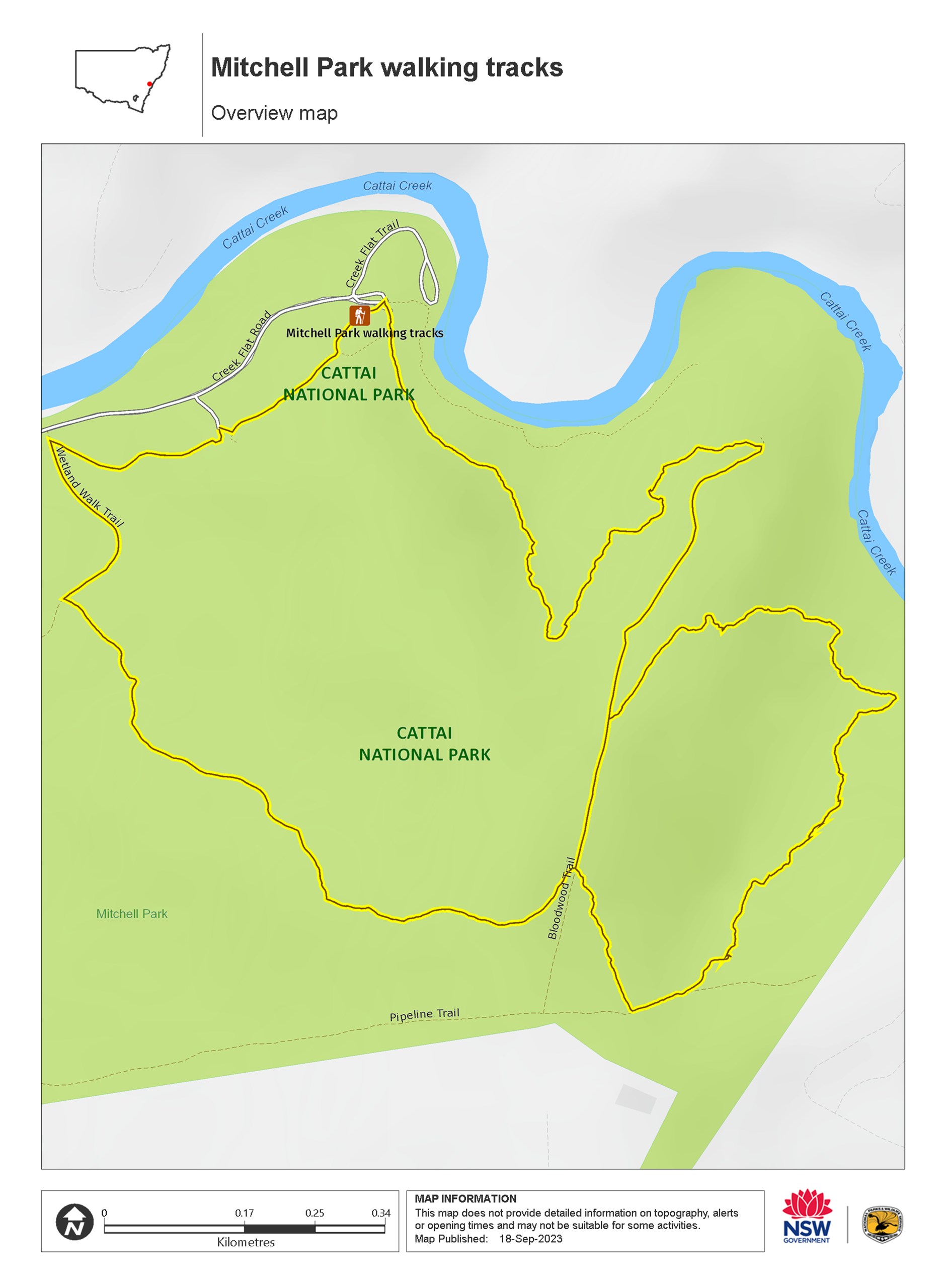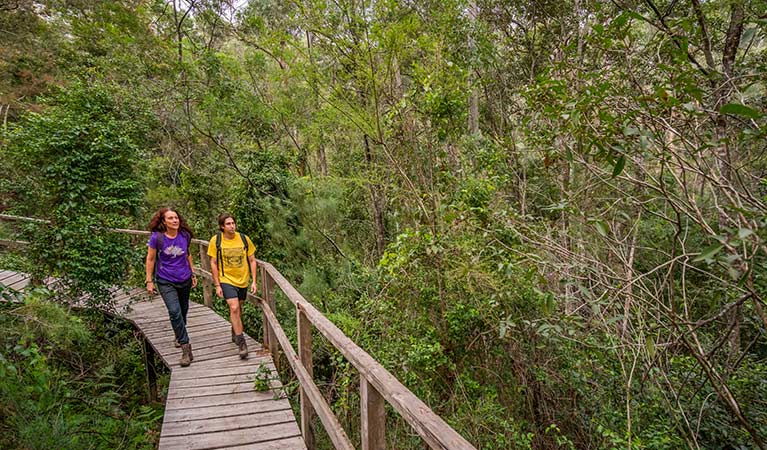Overview
Mitchell Park walking tracks offer several linked walks through remnant rainforest, diverse woodland and wetlands, in Cattai National Park, near Windsor.
- Where
- Cattai National Park in Sydney and surrounds
- Accessibility
- No wheelchair access
- Distance
- 6km loop
- Time suggested
- 1hr 30min - 2hrs
- Grade
- Grade 3
- Entry fees
- Park entry fees apply
- What to
bring - Hat, sunscreen, drinking water, snacks, insect repellent, sturdy shoes
- Please note
- You can also enjoy a shorter, 4km loop by taking a shortcut from Bloodwood trail to Scribbly Gum track, to avoid the steeper Old Man Banksia track.
- The family friendly 30min loop on Rainforest walk, and along Cattai Creek via Creek Flat track, is around 2km.
Set out from Creek Flat Road, near Mitchell Park picnic area, through beautiful dry rainforest and ironbark woodland along Rainforest walking track. For a short, kid friendly option you can loop back via easy Creek Flat track, which meanders along Cattai Creek.
The main walk continues along the gently climbing Bloodwood trail, named for its bloodwood trees with their crumbly red bark. For a 4km loop walk, skip Old Man Banksia track and connect with Scribbly Gum track. Or, stretch your legs on the steeper stretches of Old Man Banksia track before following Scribbly Gum track through lovely open woodland of scribbly gums. From here, you can join gentle Wetlands walk which takes you back to the carpark and picnic area.
These peaceful walks are a great way to discover Cattai National Park’s diverse remnant forest, just 1 hour from Sydney. Year-round you’ll enjoy wildflowers and spot some of the 150 bird species that visit, from glossy black cockatoos to rare regent honeyeaters.
After your walk, refuel with lunch at the picnic area. Bring your fishing rod, or kayak along Cattai Creek to the Hawkesbury River. Nearby, you can camp at Cattai campground and explore historic Cattai Homestead, or head to Scheyville National Park for more walks.
Map

Map legend

Local alerts
For the latest updates on fires, closures and other alerts in this area, see https://www.nationalparks.nsw.gov.au/things-to-do/walking-tracks/mitchell-park-walking-tracks/local-alerts
General enquiries
- National Parks Contact Centre
- 7am to 7pm daily
- 1300 072 757 (13000 PARKS) for the cost of a local call within Australia excluding mobiles
- parks.info@environment.nsw.gov.au
Park info
- in Cattai National Park in the Sydney and surrounds region
Cattai National Park is open 8am to 6pm from May to August and 8am to 8pm from September to April. The park may have to close at times due to poor weather or fire danger.
-
Park entry fees:
$8 per vehicle per day (including motorbikes). Day passes are available from on-park pay machines that accept coins and credit cards, and you can also pay for your visit via the Park’nPay app.
Buy annual pass.
Visitor info
All the practical information you need to know about Mitchell Park walking tracks.
Track grading
Features of this track
Distance
6km loop
Time
1hr 30min - 2hrs
Quality of markings
Clearly sign posted
Experience required
Some bushwalking experience recommended
Gradient
Gentle hills
Steps
Occasional steps
Quality of path
Formed track, some obstacles
Getting there and parking
Mitchell Park walking tracks are located in the Mitchell Park area of Cattai National Park.
To get there from Sydney:
- Take the A2 motorway towards Windsor
- Turn right onto Pitt Town Road at McGraths Hill and continue onto Cattai Road
- Turn right onto Mitchell Park Road, veer left onto Creek Flat Road
- Follow Creek Flat Road to the end
You can also take Old Northern Road and Wisemans Ferry Road to reach Mitchell Park Road.
Road quality
- Mixture of sealed and unsealed roads
Vehicle access
- 2WD vehicles
Weather restrictions
- All weather
Parking
Parking is available along the roadside in Mitchell Park.
By bike
Bicycles are permitted on access roads, but not on walking tracks.
Facilities
- Toilets and picnic tables are available at Mitchell Park picnic area.
- Drinking water is not available in this area.
- A Field Study Centre at Mitchell Park can be hired by school groups or tour groups. Hire fee applies. This basic facility includes a classroom, kitchen, toilets and showers.
Maps and downloads
Accessibility
Disability access level - no wheelchair access
- While these walking tracks are hard or no wheelchair access, nearby Mitchell Park picnic area offers medium access for wheelchairs, prams and visitors with limited mobility.
- The picnic area is mostly flat, with grass and gravel terrain, and easy access from parking on Creek Flat Road. Some assistance may be required on grass.
- A wheelchair-accessible toilet is located around 200m from the picnic area.
Permitted
Fishing
A current NSW recreational fishing licence is required when fishing in all waters.
Prohibited
Cycling
Bikes, including trail bikes, are not permitted on walking tracks.
Horses
Pets
Pets and domestic animals (other than certified assistance animals) are not permitted. Find out which regional parks allow dog walking and see the pets in parks policy for more information.
Smoking
NSW national parks are no smoking areas.
Learn more
Mitchell Park walking tracks is in Cattai National Park. Here are just some of the reasons why this park is special:
A birder's bounty

The park's riverside location, close to Longneck Lagoon, makes it popular with birdwatchers. Spot vulnerable black bitterns, powerful owls or rufous night herons. Visit the park's major wetland areas to observe several bird species otherwise scarce within Sydney.
- Mitchell Park walking tracks Mitchell Park walking tracks offer several linked walks through remnant rainforest, diverse woodland and wetlands, in Cattai National Park, near Windsor.
Aboriginal culture

Cattai National Park is the traditional Country of the Darug people. The park's landscape, including the river provided a rich source of food, medicine, shelter and tools for the Aboriginal people who travelled through the area. The park protects a number of ancient Aboriginal sites that are evidence of the Darug people's ancient connection to the land, you may find axe grinding grooves on rocks as well as rock engravings and art.
An important landscape

Cattai National Park lies within the Cumberland Plain, an important land system near Sydney that has been impacted by agricultural processes and urban development. Mitchell Park is significant because it contains much of its original vegetation, including paper bark, red gum, stringy bark, grey gum and cabbage gums. The best way to see the changing vegetation is along the Mitchell Park track, you'll notice that each part of the walk is named to describe the type of vegetation along that part of the walk.
Colonial history

Cattai National Park is significant because it includes a parcel of land granted to First Fleet assistant surgeon Thomas Arndell. Cattai Farm and the surrounding area was home to seven generations of Arndell's, with the land remaining with descendents of Thomas Arndell for about 180 years. Today, several historic sites invite observation and journeying into the past; Arndell's 1821 homestead, convict-built walls and roads, grain silos and ruins of a windmill believed to be Australia's oldest industrial building.
- Cattai Homestead and historic farm buildings Cattai Homestead and historic farm buildings near Windsor, just north of Sydney, are an important part of Australian history and a must-see for history buffs.
Plants and animals protected in this park
Animals
-

Common ringtail possum (Pseudocheirus peregrinus)
Commonly found in forests, woodlands and leafy gardens across eastern NSW, the Australian ringtail possum is a tree-dwelling marsupial. With a powerful tail perfectly adapted to grasp objects, it forages in trees for eucalypt leaves, flowers and fruit.
-

Sugar glider (Petaurus breviceps)
The sugar glider is a tree-dwelling Australian native marsupial, found in tall eucalypt forests and woodlands along eastern NSW. The nocturnal sugar glider feeds on insects and birds, and satisfies its sweet tooth with nectar and pollens.
-

Common brushtail possum (Trichosurus vulpecula)
One of the most widespread of Australian tree-dwelling marsupials, the common brushtail possum is found across most of NSW in woodlands, rainforests and urban areas. With strong claws, a prehensile tail and opposable digits, these native Australian animals are well-adapted for life amongst the trees.
-

Kookaburra (Dacelo novaeguineae)
Of the 2 species of kookaburra found in Australia, the laughing kookaburra is the best-known and the largest of the native kingfishers. With its distinctive riotous call, the laughing kookaburra is commonly heard in open woodlands and forests throughout NSW national parks, making these ideal spots for bird watching.
-

Brown-striped frog (Lymnastes peronii)
One of the most common frogs found in Australia, the ground-dwelling brown-striped frog lives in ponds, dams and swamps along the east coast. Also known as the striped marsh frog, this amphibian grows to 6.5cm across and has a distinctive ‘tok’ call that can be heard all year round.
-
Cumberland Plain land snail (Meridolum corneovirens)
The endangered Cumberland Plain land snail is only found on the Cumberland Plain, west of Sydney. During drought it digs deep into the soil to escape harsh conditions. Its brown shell is thin and fragile.

